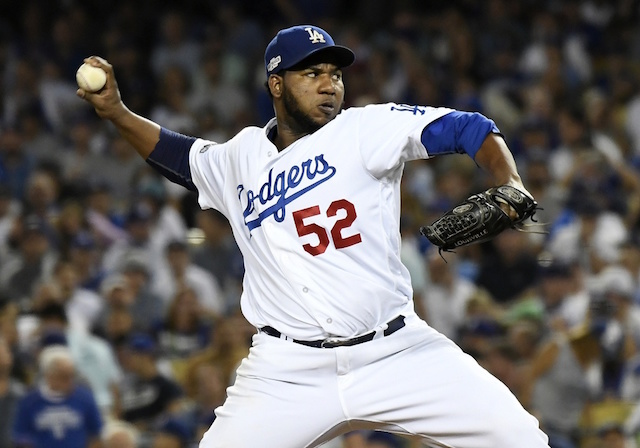Unlike the current administration, the Los Angeles Dodgers under Frank McCourt didn’t spend wildly on international free agents. Few players would get even as much as $100,000 in bonus money, and that was before limitations on total spending were implemented. However, Pedro Baez was an exception, signed for $200,000 in 2007. As a third baseman.
Baez was noted for his power bat and power arm at the hot corner, showing off plus power in batting practice and making all the plays with the glove at third. However, he batted just .229/.285/.398 in his first full season in 2008.
He bounced back in 2009, hitting .286/.326/.445 with High-A Inland Empire on his way to being named to the MLB Futures Game roster. Despite a downturn in his production the following season, Baez returned to the Futures Game, becoming the third Dodgers’ prospect to reach the game in back-to-back years, along with Chin-Feng Chen and Chin-lung Hu.
But in the following two years, he hit just .219. While Baez’s bat seemed to be failing him, he still showed the same strong arm on the infield. With his production stalling, he was converted to a relief pitcher.
In the spring of 2013, entering his first year as a pitcher, Baez earned early praise from an unlikely source. Dodgers’ legend Sandy Koufax was impressed by Baez during a bullpen session and hoped he’d see the converted third baseman with the big club during Spring Training.
Koufax didn’t get his wish. Baez stayed with the Minor League side during the spring and broke camp with High-A Rancho Cucamonga. He pitched well enough to earn a promotion to Double-A and posted a 3.88 ERA in his first season as a pitcher.
In 2014 he’d split time before Double-A and Triple-A before making his Major League debut, after just 88 games pitching in the Minors. He pitched well with the Dodgers, striking out 18 and walking just five in 24 innings while sporting a 2.62 ERA.
Baez broke camp with the Dodgers in 2015 and spent nearly the entire season up in the Majors. He saw his ERA rise to a still respectable 3.35 while his strikeout rate shot up to 28.9 percent.
This year, it was mostly more of the same. Baez’s strikeout rate was still 28 percent and his ERA at the end of the season was just 3.04. However, he was maddeningly inconsistent.
In July, the power right-hander had a spotless ERA. But come August, Baez pitched to a 7.50 ERA, all the while working at a languid pace. That resulted in him being demoted to Oklahoma City. He returned and put up more zeroes in the final month of the season.
During the postseason Baez strung together four scoreless outings against the Washington Nationals, though he did hit the only batter he faced in Game 4 as part a stressful seventh inning.
But things were different in the National League Championship Series, as Baez pitched in three games and allowed a total of six runs, including five in Game 5 (only one was earned thanks to an error on Baez).
2016 Highlight
In the process of completing a scoreless July, Baez tallied 14 strikeouts to just two walks over his 13 games and held opponents to a .064/.120/.106 batting line. He produced a similar result in September, collecting 15 strikeouts over 11.2 shutout innings.
While the Dodgers ultimately ended up losing the game, Baez pitched two scoreless innings against the Chicago Cubs in Game 1 of the NLCS.
2017 Outlook
Barring a trade, Baez should return to the seventh-inning role he occupied for most of the 2016 season.
You can listen to Jared on the weekly Dugout Blues Podcast






